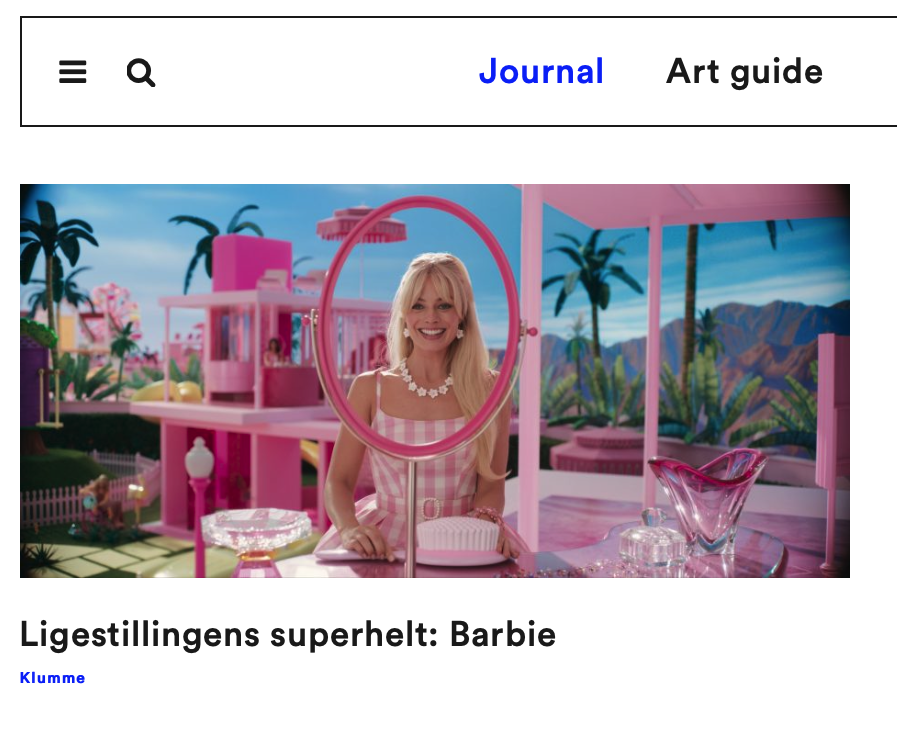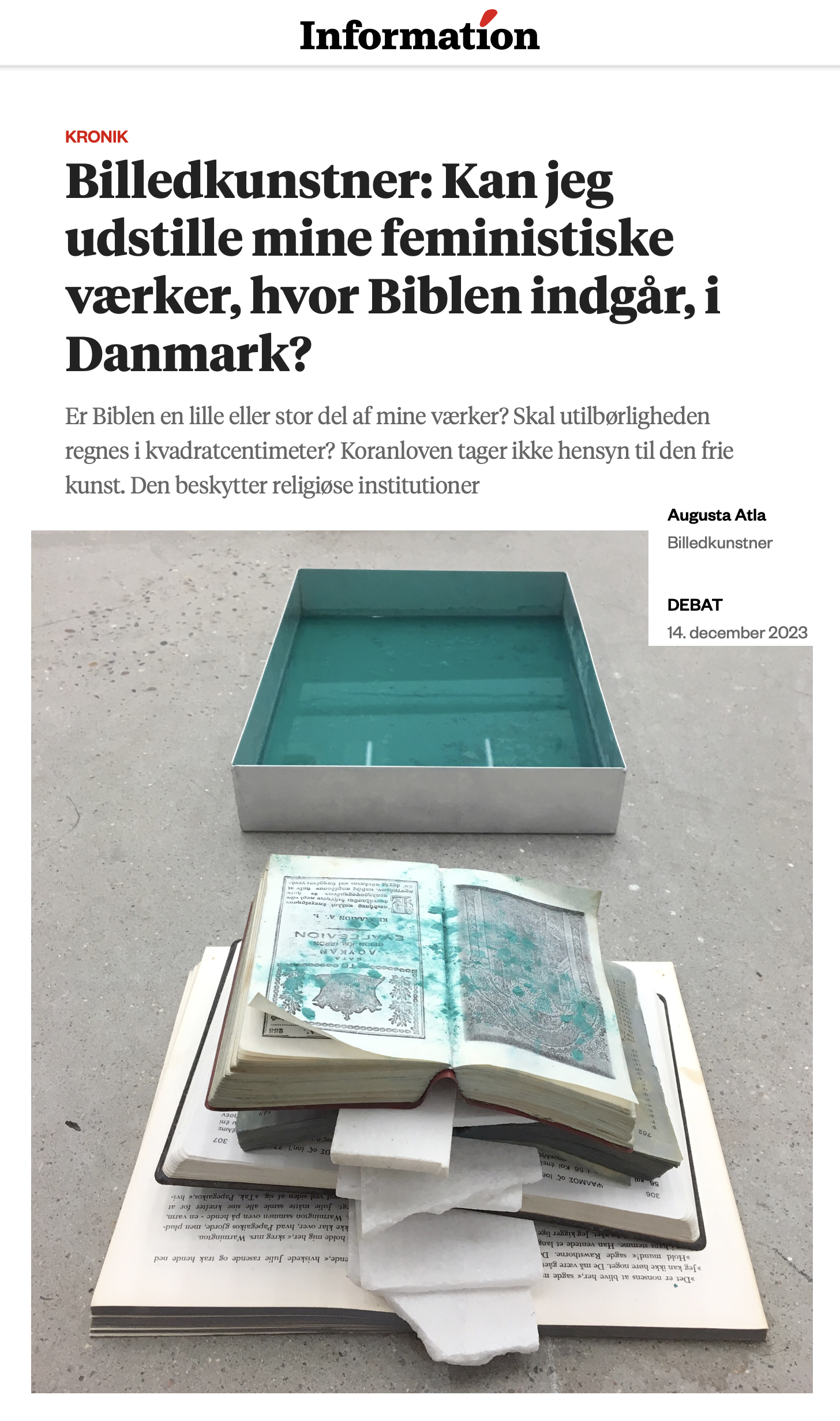Free speech, secular democracy, feminism,
artistic freedom, free sexuality and gender equality.
I discuss the backbone and virtues of our times
in relation to the political and institutional practices
of contemporary art. And anything that makes my heart miss a beat.
I fight for free speech, secular democracy, artistic freedom, feminism, free sexuality and gender equality world wide.
Opinion pieces published in various Danish newspapers. See below.
Follow my writing in English @ https://augustaatla.substack.com
Column
(2023)
kunsten.nu

November 2023
see more

October 2023
see more

August 2023
see more

July 2023
see more

May 2023
see more

see more

February 2023
see more

November 2022
see more

October 2022
see more
Writing in various newspapers

Dec 2024
see more

Sep 2024
see more

July 2024
see more

June 2024
see more

May 2024
see more

March 2024
see more

February 2024
see more

December 2023
see more

December 2023
see more

September 2023
see more

August 2023
see more

October 2022
see more

September 2022
see more

Maj 2022
see more

September 2021
see more

May 2021
see more

November 2020
see more

August 2020
see more

Marts 2020
see more

Feb 2020
see more
Editor work

May 2021
Magasinet Kunst (DK)
see more
Interview
November 2023

December 2022
Christianshavn Bibliotek (DK)

April 2022
see more

August 2022
RADIO 24Syv (DK)

May 2021
Magasinet Kunst (DK)

– volume III
October 2020
Børsen Pleasure (DK)

– volume II
August 2020
CHART PUBLICATION (DK)

– volume I
April 2020
Magasinet Kunst (DK)
Theory of Art
https://augustaatla.substack.com/p/she-is-yet-to-be-recognised-by-art
https://augustaatla.substack.com/p/the-superhero-of-gender-equality
https://augustaatla.substack.com/p/when-will-the-public-get-access-to
The Canon of the History of Art
https://augustaatla.substack.com/p/the-story-of-art-without-men
The Power of Art
https://augustaatla.substack.com/p/museum-collections
https://augustaatla.substack.com/p/when-politicians-take-the-lead-with
https://augustaatla.substack.com/p/art-history-and-national-art-collections
https://augustaatla.substack.com/p/diversity-a-premise-for-innovation
https://augustaatla.substack.com/p/diversity-in-danish-art-interview
In 2003, when I applied for art education in London, my work was already back then about gender issues and the body as political. Throughout the years 2003-2008 I tried to develop a free art practice which did not unconsciously employ art history’s biased gender issues on the figure and the body.
In 2003-2009 I was introduced to the much loved and groundbreaking books by Linda Nochlin, Gill Perry, Griselda Pollock, Judith Butler, Whitney Chadwick and Germaine Greer.
In order to further my own art practice to not rely on the fiction of a male made art history, in 2009, I initiated a conscious research project for myself, to find out more about women artists in history, as I refused to rely on the fairytale of a purely “male” canon of art history. Frankly, I did not believe it.
The following years, especially in 2009-2016, I visited libraries and folk, cultural history, art and textile museums in Europe, and I researched online in order to dig into this forgotten and erased part of history. Since I was brought up with an art historian mother and knew from very early age the traditional canon of art, I literally and deliberately wanted to reprogram my brain.
In 2018 I made my research “public” and started the instagram profile @womenpainters as a memory board of my research about women artists.
In 2019 I came up with the idea of an issue of Magasinet Kunst (DK) devoted to women and gender issues and I was co-editor on this special women in the arts edition in 2021. The magazine also included a critical essay of mine, on the Danish art scene.
In 2020, prompted by the lack of equality in the Danish art scene, I initiated a regular series of conversations with key people – people who are working to create real change vis-à-vis gender equality among artists.
In 2020 I interviewed the art collector and patron Valeria Napoleone, and the interview was published in Magasinet Kunst, CHART Publication and Børsen.
In 2021 I interviewed Camille Morineau, an acclaimed curator and art historian, on the subject of gender equality in the world of art. In 2009-2011, Camille Morineau devised and curated the pioneering exhibition Elles@centrepompidou at the Pompidou Centre in Paris. She is also the co-founder and director of AWARE, a non-profit organisation, research centre and archiving platform that promotes work by women artists. It is crucial to talk about female artists and feminist work – they have been forgotten, they have not been heard, their works have not been shown or, as the French art historian Camille Morineau has said, “they have simply been erased from history“.
In 2022 I interviewed the Minister of Culture in Denmark on diversity in the world of visual arts in Denmark.
Gender is not just a trend that fills in gaps in the history of art, but also an essential part of art history and art theory, on equal footing with new areas of basic research that redefine the history of art – forcing it to take a long hard look at itself and its methodology.
However, all this work and research – now also published writing – is not just about changing the world or the art scene around me towards more diversity. It is indeed also for myself to keep an innovative look art history, and to feed a fresh conversation about life and identity, and very importantly to further and thrive in my own art practice, that is, an art practice which continuously and “as far as it is possible” is NOT rooted in gender discrimination.
“If you do a Gerhard Richter show, people think it will be a blockbuster. It won’t be. Whereas Hilma will. Museums at the level of program and board are suffering from being behind the times.”
Helen Molesworth, former Chief Curator at the Museum of Contemporary Art, Los Angeles
“The primary ambition of AWARE is to rewrite the history of art on an equal footing. Placing women on the same level as their male counterparts and making their works known are long overdue,” states Camille Morineau on AWARE’s website
“Let’s take as our basis that men and women are equally good artists, and then say, ‘Okay, if they are equal then why is there this difference in the market?’ It starts with the galleries. They don’t represent enough women in their program. There is also a structural issue: you need to educate collectors and you need to confront them with quality.”
Marc Payot, Partner and Vice President, Hauser & Wirth
“I call bullshit on the idea that it takes a while to see change. How much more time does it take? If a new generation of art historians and curators have to be re-sensitized to this then, my God, We have amnesia at this point. It really comes down to people putting their money where their mouths are.”
Michelle Millar Fisher, Curator, Museum of Fine Arts, Boston
“There is a perception that change has been so substantial, when the reality is not the case. There is such a huge imbalance that some kind of radical gesture is required.”
Jessica Morgan, Director of the Dia Art Foundation
“When it comes to silencing women, Western culture has had thousands of years of practice.”
Quote from Women & Power by Mary Beard (Professor of Classics, University of Cambridge)









